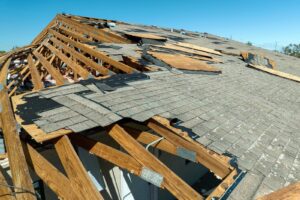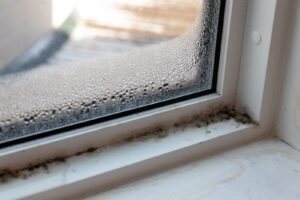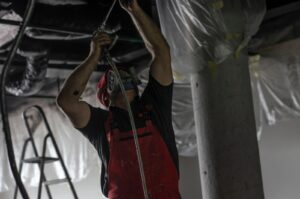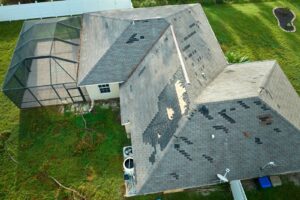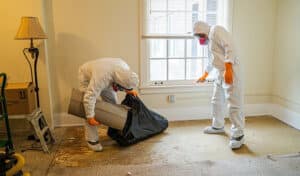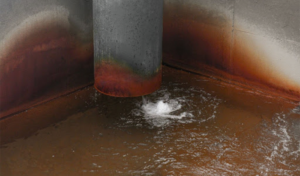When powerful winds or severe storms pass through, they can leave a trail of storm damage in their wake. The interior and exterior of your home and landscaping often bear the brunt of such weather events. From uprooted trees to broken fences and displaced furniture, wind damage can wreak havoc on your outdoor space.
This blog will teach you how to identify the signs of wind damage and discover the best action to ensure a safe and resilient outdoor environment that can withstand future storms. A wind storm is no joke, but restoring your home is possible.
Keep reading to learn more!
External Signs of Wind Damage From a Wind Storm
Roof Damage
- Missing or Damaged Shingles/Tiles: This damage tends to leave parts of a roof uncovered, rendering it susceptible to moisture damage or leaks. Signs of missing or damaged shingles include bare roof patches, exposed nails, or a visible gap between the shingles.
- Lifted or Curled Shingles: Wind can cause shingles to loosen or lift, leaving the roof vulnerable to water and moisture. Over time, this can cause the shingles to curl or misalign, no longer providing adequate coverage for the roof deck. This can lead to leaks, water stains, or even mold growth.
- Flashing Damage: Flashing refers to the protective material installed around chimneys, vents, skylights, and other roof protrusions to prevent water from seeping into the underlying structure. Wind damage can cause flashing to become loose, cracked, or completely detached.When flashing is damaged, it compromises the integrity of your roof’s waterproofing system, increasing the risk of water penetration and subsequent leakage.
- Cracked or Broken Roof Tiles: Roof tiles are essential to a durable and sturdy roof, but they can be susceptible to damage from high winds. Cracked or broken roof tiles are one of the most common signs of wind damage to a roof. Damage can occur visibly or beneath the surface, which may not be detected immediately. Broken or cracked tiles leave a roof vulnerable to moisture, wind-driven rain, and pests like insects and rodents.
Structural Damage
- Leaning or Partially Collapsed Walls: In severe cases of wind damage, the structural integrity of a building can be compromised, leading to leaning or partially collapsed walls. This is a serious safety concern and requires immediate attention from professionals. Leaning walls can be an indication of weakened foundations or damaged structural supports. If not addressed promptly, there is a risk of further collapse, which can put occupants at significant risk. Signs of leaning or partially collapsed walls include visible cracks, gaps, or a noticeable tilt in the structure.
- Cracked or Crumbling Brickwork: High winds can also cause damage to the exterior of a building, including cracked or crumbling brickwork. While brick may seem durable, it can be susceptible to wind damage, especially if the mortar has weakened over time.
- Damage To Chimney: Chimneys are particularly vulnerable to wind damage due to their height and exposed position on the roof. High winds can cause various types of damage to chimneys, including loose or dislodged bricks, damaged mortar joints, leaning or tilting chimneys, and even complete collapse in extreme cases. A damaged chimney not only compromises the structural integrity of your home but also poses a significant risk in terms of fire hazards and the potential release of harmful gases.
Wind and Door Damage
- Broken or Cracked Glass: During high winds or severe storms, windows and other glass surfaces can be vulnerable to damage. Broken or cracked glass not only compromises the aesthetic appeal of your home but also poses safety and security risks. A broken window can allow moisture, wind, and debris to enter your home, potentially causing further damage to your interior and belongings. Additionally, it can create a security vulnerability, making it easier for intruders to access your home.
- Misaligned or Difficult-to-close Doors/Windows: After a severe storm or high winds, you may notice that your doors or windows are misaligned or challenging to close. This can happen due to the pressure changes caused by the intense winds or the impact of flying debris.Misaligned doors and windows can create gaps, allowing drafts, moisture, and pests to enter your home. They can also compromise the security of your property.
Internal Signs of Wind Damage From a Wind Storm
- Water Damage
- Leaks or moisture stains on ceilings or walls: These can occur when the strong winds drive rainwater into vulnerable areas of your home, such as damaged roof shingles or gaps around windows or doors.
Leaks and moisture stains compromise the integrity of your home’s structure and create an environment conducive to mold and mildew growth, leading to potential health hazards. - Damp or musty odors: Following a storm or extended period of rain, you may notice damp or musty odors in your home. These odors often indicate the presence of moisture or dampness, which can be caused by water infiltration through damaged areas such as roofs, windows, or walls.
- Mold growth: In the aftermath of a storm, excessive moisture and water intrusion can create an ideal environment for mold growth in your home.
Mold, visible as black spots or patches, can appear on walls, ceilings, and other damp surfaces. It threatens the structural integrity of your home and poses significant health risks to those living in it. Mold exposure can lead to respiratory problems, allergies, and even more severe health issues.
- Leaks or moisture stains on ceilings or walls: These can occur when the strong winds drive rainwater into vulnerable areas of your home, such as damaged roof shingles or gaps around windows or doors.
- Cracks in walls or ceilings
- Hairline cracks: After a storm or high winds, you may notice hairline cracks on walls, ceilings, or the foundation of your house.
These cracks often appear due to the expansion and contraction of building materials caused by changes in humidity and temperature. While hairline cracks are generally not a cause for immediate concern, they can indicate underlying structural issues affecting your home’s stability. - Wide cracks or bulges: In the aftermath of a storm or prolonged rain, you may notice wide cracks or bulges on the walls, ceilings, or foundation of your home.
These cracks, while often caused by sudden shifts or movements in the building due to excessive moisture and pressure, can indicate serious structural problems affecting your home’s stability, potentially putting you, your family, and your belongings at risk. - Separation at the joints: After a storm or high winds, you may notice separation at the joints of your home, such as between walls and ceilings or where walls meet the floor. This separation can occur due to the shifting of building materials caused by pressure changes, moisture, or even structural issues.
- Hairline cracks: After a storm or high winds, you may notice hairline cracks on walls, ceilings, or the foundation of your house.
- Electrical Issues
- Frequent circuit breaker trips: You may experience frequent circuit breaker trips in your home after a storm or prolonged rain. These electrical issues are often caused by excessive moisture or water damage to your electrical wiring or appliances.
Circuit breakers serve as a safety mechanism to protect your home by shutting off electricity when it senses an overload or short circuit. Frequent circuit breaker trips can indicate underlying electrical problems and pose potential fire hazards, making them critical issues that require prompt attention. - Flickering lights: If you notice flickering lights in your home, especially after a storm or heavy winds, it may indicate an underlying electrical issue that requires attention. Various factors, such as loose connections, damaged wiring, or overloaded circuits, can cause flickering lights.
While occasional flickering may be attributed to temporary fluctuations in the electrical supply, persistent or severe flickering can signify a more significant problem.
- Frequent circuit breaker trips: You may experience frequent circuit breaker trips in your home after a storm or prolonged rain. These electrical issues are often caused by excessive moisture or water damage to your electrical wiring or appliances.
- Electrical outlets not functioning: If your home’s electrical outlets are not functioning, it can be frustrating and inconvenient. This issue can be caused by various factors, ranging from simple problems to more complex electrical issues.
Simple issues, such as a tripped breaker or a blown fuse, can cause an outlet to stop working. In such cases, resetting the breaker or replacing the fuse may solve the problem. However, if these basic remedies don’t work, it may indicate more significant electrical issues like faulty wiring or a damaged outlet.
Landscaping Signs of Wind Damage From a Wind Storm
- Uprooted or damaged trees: After a strong wind event, one of the most noticeable landscaping signs of wind damage can be uprooted or damaged trees. The powerful force of the wind can uproot trees from the ground, causing them to topple over or lean at dangerous angles. This not only poses a risk to your property but also to the safety of people nearby.
Even if a tree is not entirely uprooted, it may still suffer from broken branches, split trunks, or structural damage. These issues can weaken the tree, making it susceptible to further damage or collapse in future storms. - Broken or leaning fences: Strong gusts can exert immense pressure on fences, causing them to weaken, break, or become dislodged from the ground. This damage compromises your property’s security and privacy and affects your landscaping’s overall aesthetics. Broken or leaning fences can also pose safety risks, especially if they are in danger of collapsing.
- Displaced or damaged outdoor furniture: After experiencing strong winds or severe storms, it is not uncommon to find displaced or damaged outdoor furniture in your yard or patio. The force of the wind can easily lift lightweight furniture and scatter it across your property or even neighbor’s yards.
Additionally, heavy gusts can cause damage to furniture by toppling it over or knocking it against structures or other objects. This can result in broken chairs, damaged tables, or bent frames.
Restore Your Home With Restoremasters
As you can see, there are many ways for wind and storm damage to impact your home. At Restoremasters, we understand how difficult it can be to handle storm damage. That’s why we offer professional restoration services to help you restore your outdoor space to its pre-damaged condition. Don’t wait until the next wind event to take action.
Contact Restoremasters today at 801.948.2478 for your wind damage restoration needs.


